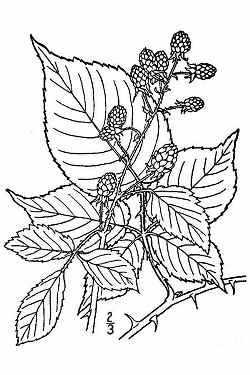
Rubus allegheniensis, Britton, N.L., and A. Brown. 1913. Illustrated flora of the northern states and Canada. Vol. 2: 280. Courtesy of Kentucky Native Plant Society.
Sunset®: 1-9,14-41
USDA: 3-11
Sun Exposure: Full sun to part sun
Origin: Cultivated varieties are hybrids of various Rubus species.
Growth Habits: Shubby vines, depending on the variety, can be from trailing to erect
Watering Needs: Regular water
Propagation: Root cuttings in winter (erect blackberries only), division in the fall or early spring, leafy stem-cuttings in summer, tip layering
Selected Varieties for the Low Deserts
| Variety | Zones (Sunset) | Maturity Zone 13 | Remarks |
| Brazos | 4/15-5/15 | (Rubus lanciniatus) Very vigorous, thorny, erect plant which produces an abundance of large high quality berries. Brazos does not require cross-pollination. Berries are large, attractive appearance and heavy yields, tart acid flavor. Developed by Texas A&M. | |
| Rosborough | 4/15-5/15 | Vigorous moderately upright canes which produces well in a wide variety of soil and climatic conditions. Fruit are large, attractive in appearance and have a sweeter flavor than Brazos. Developed by Texas A&M. | |
| Womack | 4/15-5/15 | Vigorous moderately upright canes, prefers deep sandy soils. Fruit are medium to large, attractive in appearance and have a sweeter flavor than Brazos, smaller than Rosborough. Developed by Texas A&M. |
Desert-Tropicals is dedicated to provide gardening advice, gardening ideas, and information about flower of all kind for landscape and collections.We try to check carefully the identification of the plants on the illustrations as well as the other information from the page, but occasionally errors do occur. if you notice anything that needs to be changed please contact us.Thanks.
© 1998-2020 Philippe Faucon, All Rights Reserved.